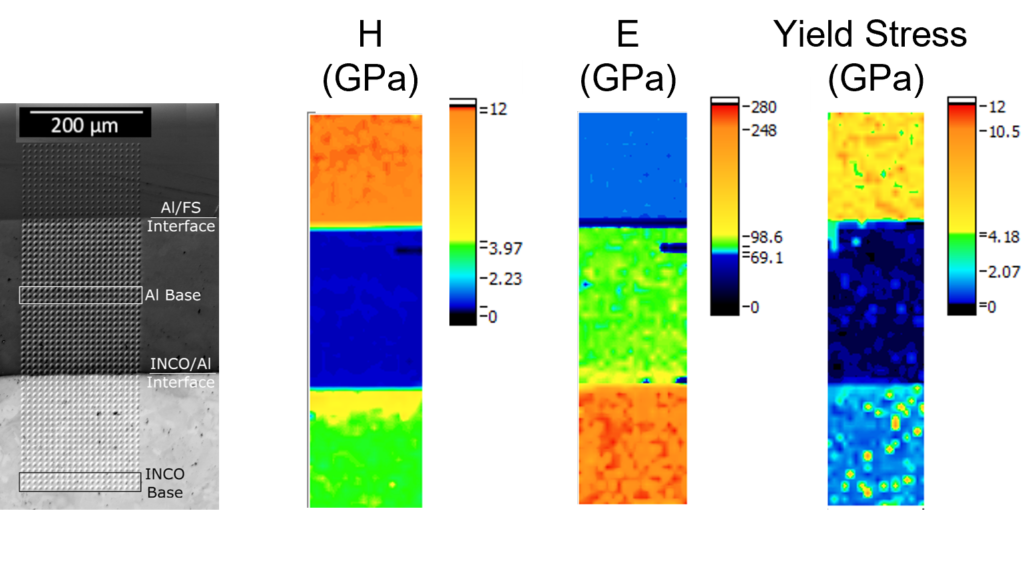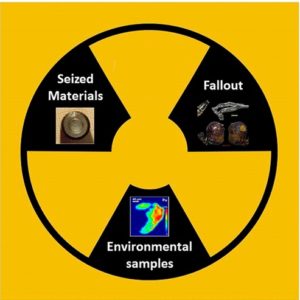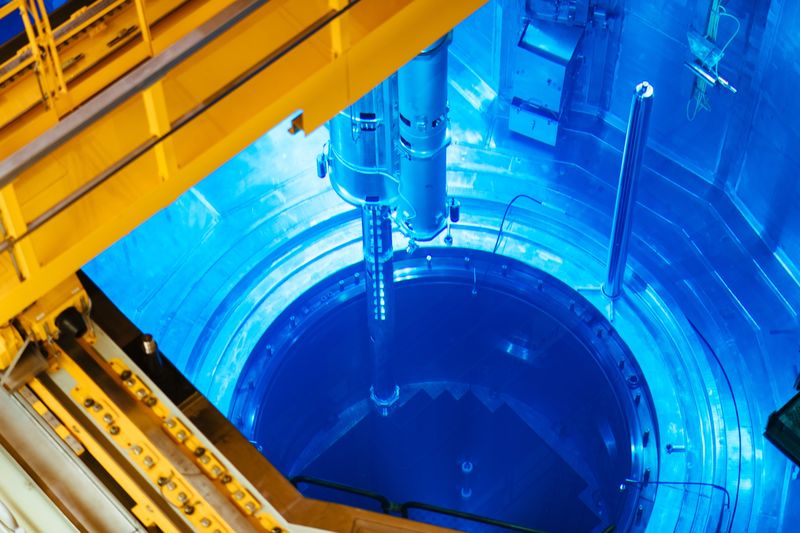NUCLEAR
Economic and safety concerns for current and next generation nuclear applications call for research and development of advanced materials. At Alemnis AG, we are experienced with the challenging environments of nuclear research:
The Alemnis Standard Assembly (ASA) micromechanical testing platform tolerates high levels of radiation, offers full flexibility for remote sample handling tasks, and can be used with both optical and scanning electron microscopes. The ASA was designed to test extremely small volumes of material such as micropillars, microbeams, and particles. Because the volume of such samples typically fall within the range of only 20 – 200 µm3, the level of radiation remains favorably low.
Quick Links
Reference customers
Alemnis AG has extensive experience in integrating micromechanial testing platforms into existing infrastructure for nuclear research. Thanks to the flexibility of our Alemnis Standard Assembly, it is possible to use it in a variety of environments ranging from standard scanning electron microscopes, over gloveboxes, to shielded lines. The unique mechanical robustness and irradiation tolerance combined with the possibility for customized solutions for remote sample handling and instrument control make it the top choice for nuclear research facilities world-wide.

Fission
The Alemnis Standard Assembly has already been used for many studies of radioactive materials, as well as proposed replacement candidate materials for existing fission reactors.

Advantages of micro-scale mechanical testing
Radiation levels of materials reduce along with their mass. This makes handling of microscale samples much simple compared to samples for traditional mechanical testing. Beyond the practical advantages, there are also a number of advantages from the scientific point of view:
- Small-scale properties give useful inputs for modelling
- Deformation phenomena can be better understood
- Often concerned with localized areas: grains, phases, grain boundaries, interfaces, inclusions, crack growth, particles, etc..
- Sometimes, only very small material volumes are available for analysis (e.g., nuclear forensics, fuel particles, etc..)
Understanding particle mechanical properties means that larger agglomerate properties can be better modelled and understood.
Evaluating the degradation of mechanical properties of materials under irradiation is crucial for nuclear structural materials. However, macroscopic mechanical tests on ion-irradiated materials are challenging due to the shallow irradiation depth. Micromechanical tests, on the other hand, can probe materials on length-scales that are comparable with irradiation depths.

Henry, R., et al. (2020). Irradiation effects on the fracture properties of UO2 fuels studied by micro-mechanical testing. Journal of Nuclear Materials, 536, 152179.
Fusion
Fusion reactors pose extreme challenges for structural materials selection due to severe in-service conditions. Viewing ports, for example, are complex assemblies of multiple materials including fused silica, an Inconel ferrule, and an aluminium bonding layer, where the joint is consolidated trough a diffusion bonding process. The precise design parameters of such windows are object to continuous improvements. A major role in this effort plays three-dimensional finite element model (FEM). Importantly, these FEM simulations require stress-strain curves as input parameters. Such curves are difficult to obtain from complex systems with dissimilar joints. In the example below, dynamic spherical nanoindentation was used to map the stress-strain characteristics across the diffusion bonded joints. A fully automated post-processing protocol can extract tensile-like properties including yield stress, yield strain, work hardening parameters and elastic moduli.


Automated mechanical characterization mapping of a viewing port assembly of the ITER fusion reactor.
Forensics
Advances in nuclear forensics are directly linked to the development of microanalytical techniques. Nowadays, full characterization and attribution of radioactive samples is possible with only nanograms of material. Micromechanical properties of dust particles are important variables in the description of materials of unknown provenance, and Alemnis AG is pioneering this application in collaboration with international nuclear research facilities.

References
(1) Mast, B.; Cambriani, A.; Douvalis, A. P.; Pontikes, Y.; Schroeyers, W.; Vandoren, B.; Schreurs, S. The Effect of High Dose Rate Gamma Irradiation on the Curing of CaO-FexOy-SiO2 Slag Based Inorganic Polymers: Mechanical and Microstructural Analysis. J. Nucl. Mater. 2020, 539, 152237. https://doi.org/10.1016/j.jnucmat.2020.152237
(2) Fazi, A.; Aboulfadl, H.; Iyer, A. H. S.; Sattari, M.; Stiller, K. M.; Lokhande, P.; Thuvander, M.; Andren, H. O. Characterization of As-Deposited Cold Sprayed Cr-Coating on Optimized ZIRLOTM Claddings. J. Nucl. Mater. 2021, 549, 152892. https://doi.org/10.1016/j.jnucmat.2021.152892
(3) Jenczyk, P.; Jarzabek, D. M.; Lu, Z.; Gadalińska, E.; Levintant-Zayonts, N.; Zhang, Y. Unexpected Crystallographic Structure, Phase Transformation, and Hardening Behavior in the AlCoCrFeNiTi0.2 High-Entropy Alloy after High-Dose Nitrogen Ion Implantation. Mater. Des. 2022, 216, 110568. https://doi.org/10.1016/j.matdes.2022.110568
(4) Wang, S.; Giuliani, F.; Britton, T. Ben. Variable Temperature Micropillar Compression to Reveal Basal Slip Properties of Zircaloy-4. Scr. Mater. 2019, 162, 451–455. https://doi.org/10.1016/j.scriptamat.2018.12.014
(5) Jóźwiak-Niedźwiedzka, D.; Dąbrowski, M.; Dziedzic, K.; Jarząbek, D.; Antolik, A.; Denis, P.; Glinicki, M. A.; Jo, D.; Dziedzic, K.; Da, M. Effect of Gamma Irradiation on the Mechanical Properties of Carbonation Reaction Products in Mortar. Mater. Struct. 2022, 0123456789 (6), 164. https://doi.org/10.1617/s11527-022-02003-w
(6) García-Junceda, A.; Puricelli, L.; Valsesia, A.; Rossi, F.; Colpo, P.; Ruiz-Moreno, A. Novel Fabrication Routes of Metallic Micromembranes for In Situ Mechanical Testing. Metals. 2022. https://doi.org/10.3390/met12030468
(7) Beausoleil, G. L.; Cinbiz, M. N.; Yao, T.; Wang, Y.; Lemma, F. Di; Adkins, C.; Pavlov, T.; Williams, W. J.; Song, R.; Capriotti, L. U-50Zr Microstructure and Property Assessment for LWR Applications; United States, 2021. https://doi.org/10.2172/1825221
(8) Wang, S.; Kalácska, S.; Maeder, X.; Michler, J.; Giuliani, F.; Britton, T. Ben. The Effect of δ-Hydride on the Micromechanical Deformation of a Zr Alloy Studied by in Situ High Angular Resolution Electron Backscatter Diffraction. Scr. Mater. 2019, 173, 101–105. https://doi.org/10.1016/j.scriptamat.2019.08.006
(9) Kabel, J.; Edwards, T. E. J.; Hain, C.; Kochetkova, T.; Parkison, D.; Michler, J.; Hosemann, P. A Novel Fiber-Fretting Test for Tribological Characterization of the Fiber/Matrix Interface. Compos. Part B Eng. 2021, 206, 108535. https://doi.org/10.1016/j.compositesb.2020.108535
(10) Virkkunen, I.; Peltonen, M.; Sirén, H.; Nevasmaa, P.; Huotilainen, C.; Keinänen, H.; Kuutti, J.; Lambai, A.; Mohanty, G.; Honkanen, M. A52M/SA52 Dissimilar Metal RPV Repair Weld: Experimental Evaluation and Post-Weld Characterizations. ASME 2020 Pressure Vessels & Piping Conference. August 3, 2020. https://doi.org/10.1115/PVP2020-21236
(11) Barnoush, A.; Hosemann, P.; Molina-Aldareguia, J.; Wheeler, J. M. In Situ Small-Scale Mechanical Testing under Extreme Environments. MRS Bull. 2019, 44 (6), 471–477. https://doi.org/10.1557/mrs.2019.126.
(12) Pero, R.; Randall, N.; Frey, D.; Widmer, R.; Darby, T.; Aucott, L.; Hardie, C.; Pak S.; Maquet, P.; Bushby, A. New stress-strain indentation mapping methodology for measuring mechanical properties across diffusion-bonded interface of International Thermonuclear Experimental Reactor (ITER) window assembly. Journal of Nuclear Materials. In press.





